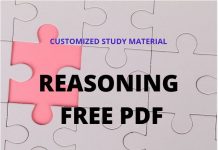 For Daily Job Alert For Daily Job Alert |
Join Our Whats App Channel |
 For Free Study Material For Free Study Material |
Join Our Telegram Channel |
Directions (Q. 1 – 10): In these questions, a
relationship between different elements is shown in
the statements. The statements are followed by two
conclusions. Given answer
(a) if only conclusion I is true.
(b) if only conclusion II is true.
(c) if either conclusion I or II is true.
(d) if neither conclusion I nor II is true.
(e) if both conclusions I and II are true.
- Statement: C ≥ D > E = M < J = L
Conclusion : I. L > E II. C ≥J - Statement: P = N ≤ Q > R > T = S
Conclusion : I. N ≥ S II. P ≤ Q - Statement: J ≥ P = I ≥ M < T ≥ V > H
Conclusion : I. M ≤ J II. H ≤ M - Statement: Q ≤ X ≤ E > F = D < O < K = G
Conclusion : I. D > Q II. K ≤ E - Statement: Q ≤ X ≤ E > F = D < O < K = G
Conclusion : I. Q ≤ E II. G > F - Statements : A > B ≥ C < D, C = E > G
Conclusions : I. D > E II. B > E - Statements : P ≤ Q > M ≥ N, Q = S
Conclusions : I. S > P II. N < S - Statements : S > M = Z > T < Q > V
Conclusions : I. V = S II. Q > M - Statements : T < U = V ≤ S > P ≥ Q
Conclusions : I. S > T II. V ≥ Q - Statements : M ≥ N > R > W, E = J > L ≥ W
Conclusions : I. E > W II. M > L
Directions (Q. 11-15):In the following questions, the symbols @, ©, %, $ and ¬ are used the following meaning as illustrated below:
‘A©B’ means ‘A is smaller than Q’.
‘A@B’ means ‘A is either smaller than or equal to Q’.
‘A%B’ means ‘A is greater than Q’.
‘A $ B’ means ‘A is either greater than or equal to Q’.
‘A¬B’ means ‘A is equal to Q’.
Now in each of these questions assuming the given statements to be true, find which of the two conclusions I and II given below them is/are definitely true? Give answer
(a) if only Conclusion I is true.
(b) if only Conclusion II is true.
(c) if either Conclusions I or II is true.
(d) if neither Conclusions I nor II is true.
(e) if both Conclusions I and II are true.
11. Statements: B © T, T ¬ M, M % F
Conclusions:
I. B © M
II. B © F
12. Statements: M ¬ R, R % T, T $ K
Conclusions:
I. K @ M
II. K © M
13. Statements: W © D, D @ H, H ¬ N
Conclusions:
I. N $ D
II. W © N
14. Statements: W @ D, D $ R, R © K
Conclusions:
I. R ¬ W
II. R % W
15. Statements: F $ J, J % V, V © N
Conclusions:
I. N $ F
II. N % J












